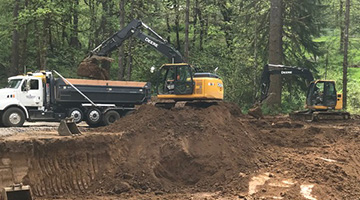Dump Truck Companies in Ohio - Trustworthy Dump Truck Providers Throughout Ohio
Unveiling the Art of Excavation: Pro Tips for Safe and Productive Excavating
As soil is turned and earth is moved, the intricacies of excavation expose themselves, requiring a keen understanding of equipment, soil composition, safety and security methods, and ecological factors to consider. The expertise needed to browse these aspects effectively can imply the distinction in between an effective excavation job and a prospective catastrophe.
Relevance of Appropriate Equipment
To ensure the safety and performance of any type of excavation job, utilizing the suitable equipment is extremely important. Excavation projects vary in range and complexity, varying from tiny household landscape design tasks to large building endeavors.
These flexible makers come in various dimensions to suit different project demands. Small excavators are perfect for smaller tasks, while bigger excavators tackle a lot more comprehensive tasks effectively.
Apart from excavators, other critical equipment includes dump vehicles, trenchers, and excavators. Unload vehicles are essential for eliminating and transporting excavated products, while plates are made use of for excavating slim and deep trenches. Excavators succeed in jobs that need pushing big quantities of dirt or particles. By purchasing the suitable equipment, excavation projects can be finished securely, on schedule, and with accuracy.
Recognizing Soil Structure
A detailed grasp of dirt composition is fundamental for implementing excavation projects with accuracy and security. Recognizing the different sorts of soil is vital as it straight influences excavation methods, equipment selection, and overall task performance. Dirt make-up normally includes 4 primary components: sand, silt, clay, and raw material. Each part has distinct buildings that affect just how soil responds to excavation processes.
Sand bits are the largest and give excellent drain yet provide little cohesion. Silt fragments are smaller than sand but larger than clay, providing moderate water drainage and communication. Clay particles are the smallest and give high cohesion however inadequate drain. Organic matter, such as rotting plant product, influences dirt fertility and stability.
Before beginning excavation, carrying out soil tests to identify its structure and attributes is vital. This details aids in picking the suitable devices, executing precaution, and developing excavation techniques customized to the certain dirt conditions - excavating ohio. By comprehending dirt composition, excavation specialists can boost project outcomes while making certain security and adherence to ideal methods
Safety And Security Measures and Protocols
Comprehending soil make-up is the foundation whereupon precaution and methods for excavation projects are developed, making sure the well-being of employees and the success of the undertaking. When it concerns security during excavation, there are several crucial steps that should be applied to alleviate dangers and prevent crashes.
First and leading, prior to any kind of digging commences, a thorough examination of the website ought to be conducted to recognize any potential hazards such as below ground utilities, unpredictable dirt problems, or close-by frameworks that might position a danger. It is essential to have a skilled person oversee the excavation process to make certain that all safety and security protocols are complied with strictly.
Additionally, all employees included in the excavation should be effectively educated in risk-free digging methods and reference the appropriate procedure of devices. By adhering to these safety procedures and protocols, excavation projects can be finished efficiently and without occurrence.
Efficient Excavation Planning
When embarking on an excavation job, precise preparation is necessary to guarantee efficiency, safety and security, and effective end results. visit this web-site Effective excavation preparation entails numerous essential steps that are vital for the smooth implementation of the project.
Once the site assessment is total, the next step is to produce a clear timeline and routine for the excavation tasks. This includes identifying the sequence of jobs, devices demands, and workforce appropriation. Appropriate organizing aids stay clear of delays and ensures that the job remains on track.

Furthermore, communication amongst all staff member is extremely important during the preparation phase. Clear regulations, normal updates, and effective coordination are necessary for an effective excavation task. By investing effort and time in meticulous planning, excavation groups can dramatically improve productivity, lessen threats, and achieve effective results.

Managing Ecological Considerations
With increasing emphasis on ecological sustainability in construction techniques, managing ecological factors to consider has actually become a crucial facet of excavation jobs. Excavation tasks have the potential to impact the surrounding environment with dirt disintegration, debris runoff, environment disturbance, and contamination of water resources. To minimize these dangers, it is necessary to apply ideal methods that focus on environmental management.

In addition, proper waste management is important to stop dirt and water contamination. Applying treatments for the disposal of hazardous products, recycling of waste materials, and lessening using dangerous chemicals can dramatically minimize the environmental impact of excavation projects. By integrating these techniques into excavation preparation and implementation, building and construction business can ensure that their jobs are not just secure and efficient however likewise environmentally accountable.
Final Thought
To conclude, mastering the art of excavation requires a complete understanding of proper visit site devices, dirt composition, safety and security procedures, and efficient planning. By complying with these guidelines and considering environmental aspects, excavations can be performed safely and effectively. It is important to prioritize security and productivity in every excavating job to make sure successful outcomes.
As dirt is transformed and earth is relocated, the complexities of excavation reveal themselves, requiring an eager understanding of equipment, dirt composition, safety procedures, and ecological considerations.To guarantee the safety and security and performance of any excavation job, making use of the suitable tools is vital.A detailed grasp of soil structure is basic for carrying out excavation tasks with precision and security. Recognizing the different types of soil is vital as it directly impacts excavation techniques, tools selection, and overall job effectiveness. By recognizing soil composition, excavation experts can improve task end results while guaranteeing security and adherence to finest practices.